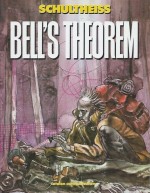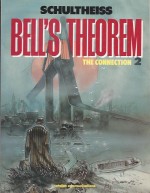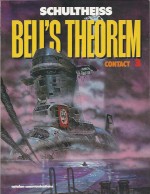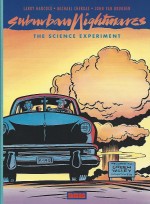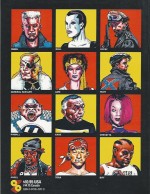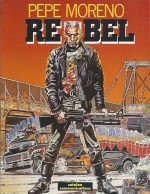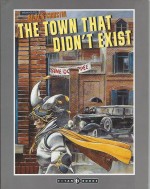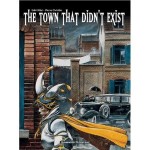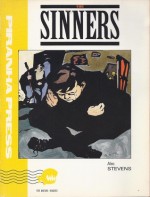
By ShÅtarÅ Ishinomori, translated by Betsey Scheiner (University of California Press)
ISBN: 978-0-52006-289-4
It’s often been said, but bears repeating here: “Comics are an integral part of Japanese lifeâ€. There’s no appreciable difference to Eastern eyes between sequential pictures and prose, so it makes sense that such a medium should be used to educate and elucidate as well as entertain. After all the US military reached the same conclusion after WWII when they commissioned comics legend Will Eisner to design instruction manuals in strip form, and produce similar instructive material for Services magazines like P*S, the Preventative Maintenance Monthly, which even the least schooled G.I. could understand…
In late 1986 Nihon Keizai Shimbun, Japan’s analogue of the Wall Street Journal, commissioned manga star ShÅtarÅ Ishinomori to adapt a serious economic text – Zeminaru Nihon keizai nyÅ«mon published by the newspaper – into a mass market comicbook. Manga Nihon keizai nyÅ«mon sold more than half a million copies in its first year…
Soon after, Securities and Investment companies were using strip brochures to explain the complexities of their latest stock market products and by the mid 1980s benkyÅ and jitsumu manga (“study comic†and “practical comicâ€) were an integral part of school and college libraries. Naturally, there were sequels to Manga Nihon keizai nyÅ«mon…
ShÅtarÅ Ishinomori (nee Onodera and Ishimori; January 25th 1938 – January 28th 1998) is officially the World’s most prolific comics artist. After his death the Guinness Book of Records posthumously recorded his 128,000+ pages – often generated at the rate of 200-300 pages a month! – the most ever produced by a single creator.
In 1955, when the boy was simply keen fan of Manga pioneer Osamu Tezuka, the God of Comics took the lad on as his assistant and apprentice, beginning with the iconic Tetsuwan Atomu – or Astro Boy to you and me…
Thereafter, until his death Ishinomori worked ceaselessly in Manga, Anime, Games and Tokusatsu (live action superhero shows such as Kamen Rider – a genre he practically invented) developing groundbreaking series such as Super Sentai, Cyborg 009, Sabu to Ichi Torimono Hikae, Ganbare!! Robokon and countless others.
There is a museum dedicated to his career in Ishinomaki, Miyagi and trains to and from the site are decorated throughout with his myriad cartoon creations.
Following a comprehensive and informative account on the development and growth of comics in Japan by Stanford University’s Peter Duus, this oddly engaging English-language edition reveals the way the Japanese perceived their own economy’s function and global position through the fictionalised lives of a small group of workers at the mythic conglomerate Toyosan Automobile Corporation and its affiliate the Mitsutomo Company.
The cast are idealised concepts of the nation’s business life: Kudo is a good and kind-hearted executive, always seeking to put profit in a social framework that benefits everybody, whilst his colleague and rival Tsugawa is a ruthless, go-getter to whom people are expendable and only the Bottom Line matters. Above them is wise manager Akiyama, with the women’s role exemplified by shy yet passionate Miss Amamiya, whilst young office junior Ueda portrays the verve, exuberance and inexperience of the next generation of Japan’s workers…
The elucidating episodes begin with ‘Trade Friction’ as in 1980 American car workers begin attacking imported Japanese cars. Ever hungry for a fast buck, the US motor industry lays off staff and attempts to force Washington into curtailing Japanese imports…
If the exporting nation is to maintain its growth, it may have to shift production to the USA and leave its own workers and subcontractors out in the cold. Soon there’s panic at Toyosan’s factory and the union is up in arms, but whilst Tsugawa has no problem with that, the ingenious Kudo is working on a plan to diversify and provide new jobs for the ordinary Japanese suffering under the outrageous US tactics…
‘Countering the Rise of the Yen’ sees the disparity in international exchange rates threaten Imahama City as their crucial export trade crumbles. When Tsugawa seizes the opportunity to buy the place cheap and turn it into a Mitsutomo amusement park, once more Kudo interferes, seeking a way to keep all the citizens of the district fully employed whilst delivering a sound lesson on the way to balance family life and duty to the company…
Geo-political affiliations and the ever-shifting balance of power in rogue states comes under scrutiny in ‘Industrial Structure’ when a Middle-Eastern country seeks to revive a secret industrial process and past alliance with Mitsutomo. The shady deals that were struck in the pursuit of guaranteed resources offer huge potential profit but a concomitant risk of disastrous political and financial fall-out if the scheme is exposed. Of course Tsugawa and Kudo and their respective mentors Toda and Akiyama are in the thick of things in a chapter dramatically illustrating how changes in international political climate reshape Japan’s industrial structure…
The nation’s welfare system is tested in ‘Deficit Finance’ as Ueda’s aged grandmother comes to visit and Japan’s social services are scrutinised by Tsugawa and Kudo, who learn the advantages and drawbacks of government-led initiatives whilst both learning some hard-hitting historical lessons about the last (in their case 1965) Recession…
‘A Monetary Revolution’ describes the inexorable global banking de-regulation of the 1970s and 1980s as Tsugawa visits London following the “suicide†of an Italian banker and falls into a hornet’s nest of trouble by involving Mitsutomo in a “Fi-Tech†scheme (covert financial speculation between banks, usually achieved by mutually monkeying with the proposed profit margin) that involves the Vatican’s Mafia-run Financial House… Anybody else positively dizzy with déjà vu…?
When it all comes bubbling to a head it’s only Kudo’s swift thinking and sharp dealing that turns an unmitigated catastrophe into a business triumph, after which the ‘Epilogue’ neatly sums up the subtly effective lessons learned throughout the book and depicts our cast as the look forward to what might lie ahead
Using a stylish soap-opera and captivatingly effective scenario to put a personal face on history – or indeed Global Finance in this case – is a technique the modern film industry has used for decades, with fictionalised accounts of historical figures and events as far-ranging as The King’s Speech to Flight 93 to Shakespeare in Love leading a vital veracity to even the most fanciful proceeding, and it works magnificently here whilst the subplots (sex, political intrigue, bribery, espionage, blackmail, sacrificing family life for the job and, of course, the war between prosperity and personal honour) all work perfectly to put a human frame to what might seem dry and dusty lecturing
Whilst not to everyone’s taste, this book certainly shows how emphatic and powerful a tool comics can be, whilst to my mind it has a far more lasting dramatic appeal than many of its contemporary money-worshipping entertainments such as Dallas, Dynasty or Wall Street…
One interesting point about this book is the perceptible subtext and open undercurrent describing a general mistrust of all politicians – shadings that most British scholarly texts are keen and careful to disguise at all costs. US President Ronald Reagan is constantly depicted as either a buffoon or a conniving demon but he gets off lightly compared to Japanese officialdom, from the lowliest local administrator or union rep all the way to the highest statesmen in the land…
Here the words and pictures don’t prevaricate: Business Good, Politicians Bad…
And on that I couldn’t possibly comment…
© 1988 the Regents of the University of California. © 1986 ShÅtarÅ Ishinimori, reprinted by permission of Nihon Keizai Shimbun, Inc.

